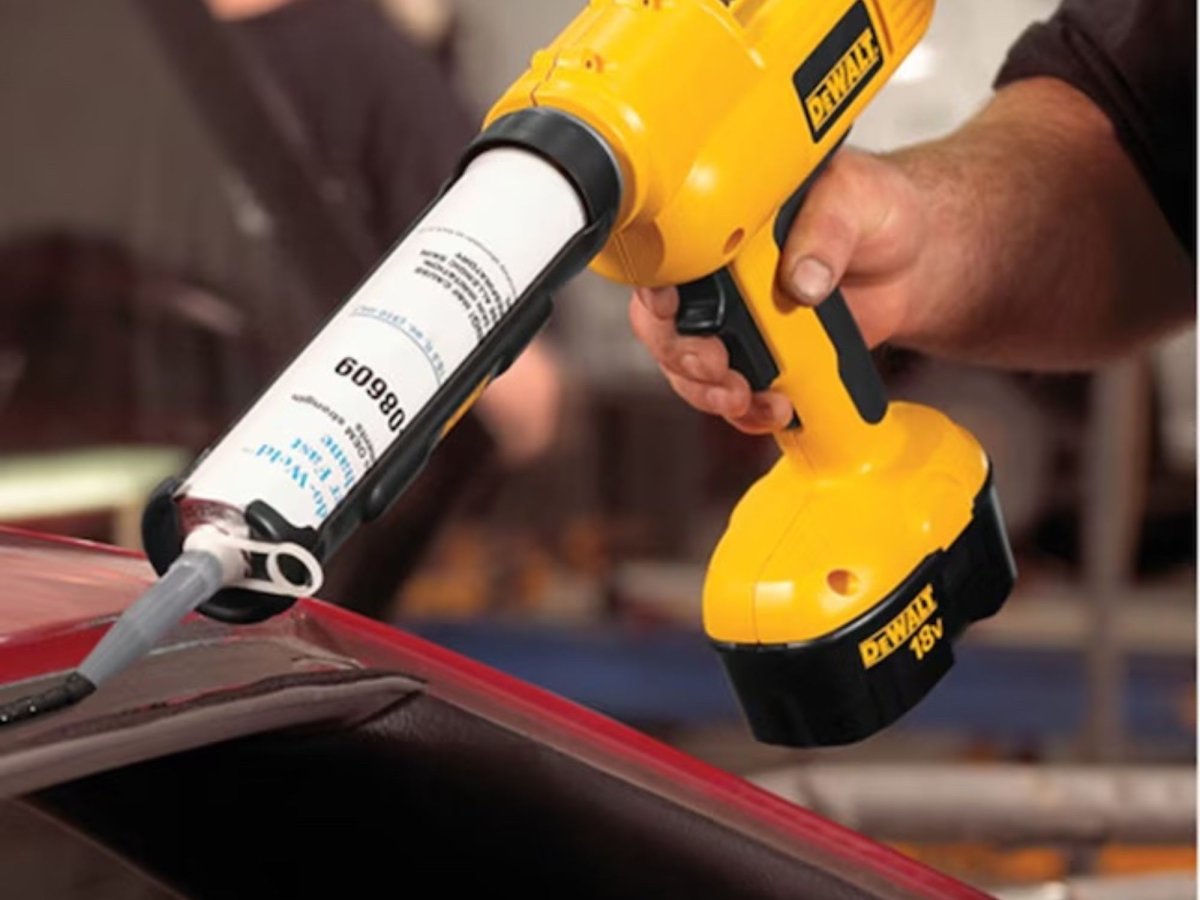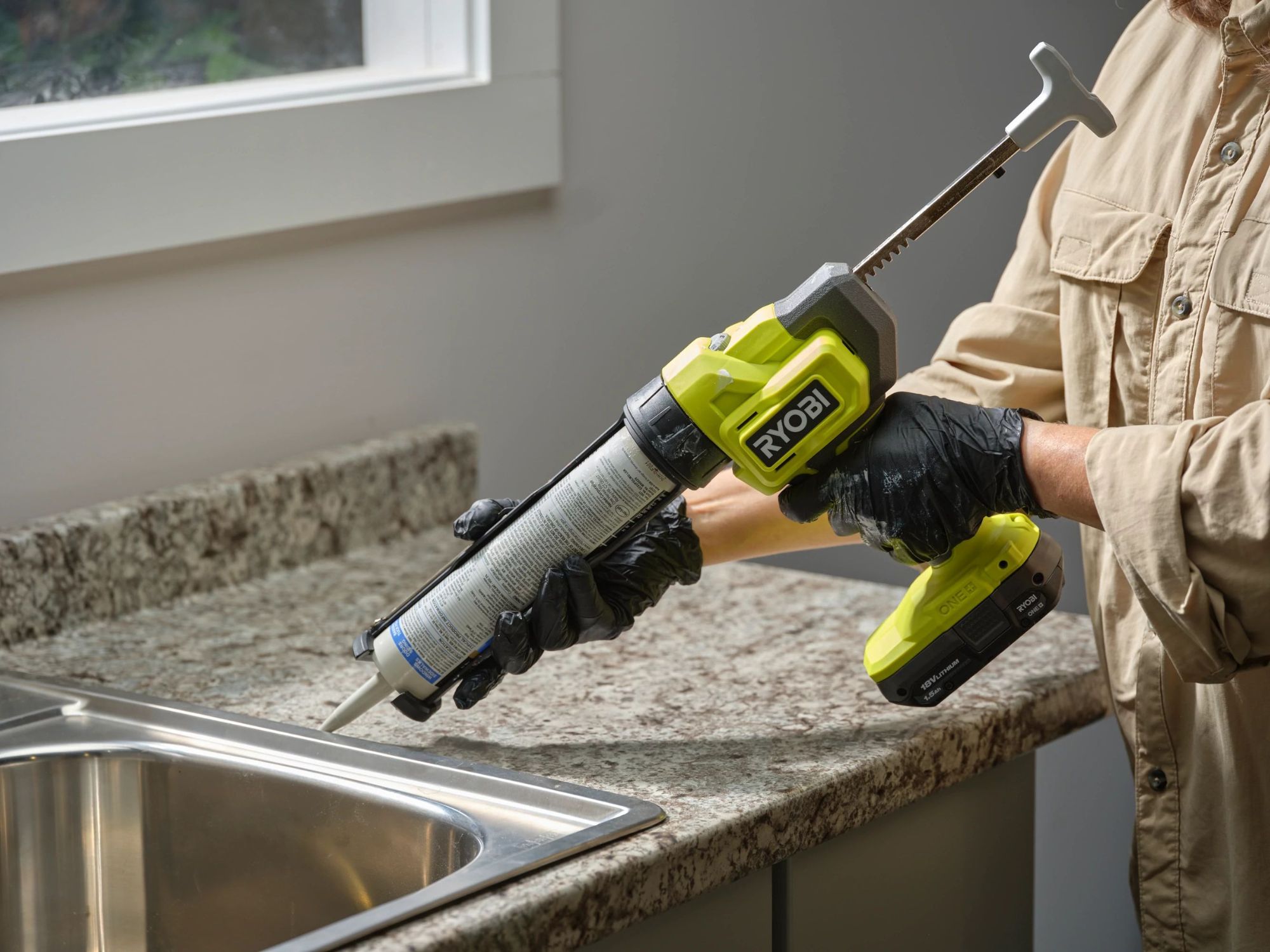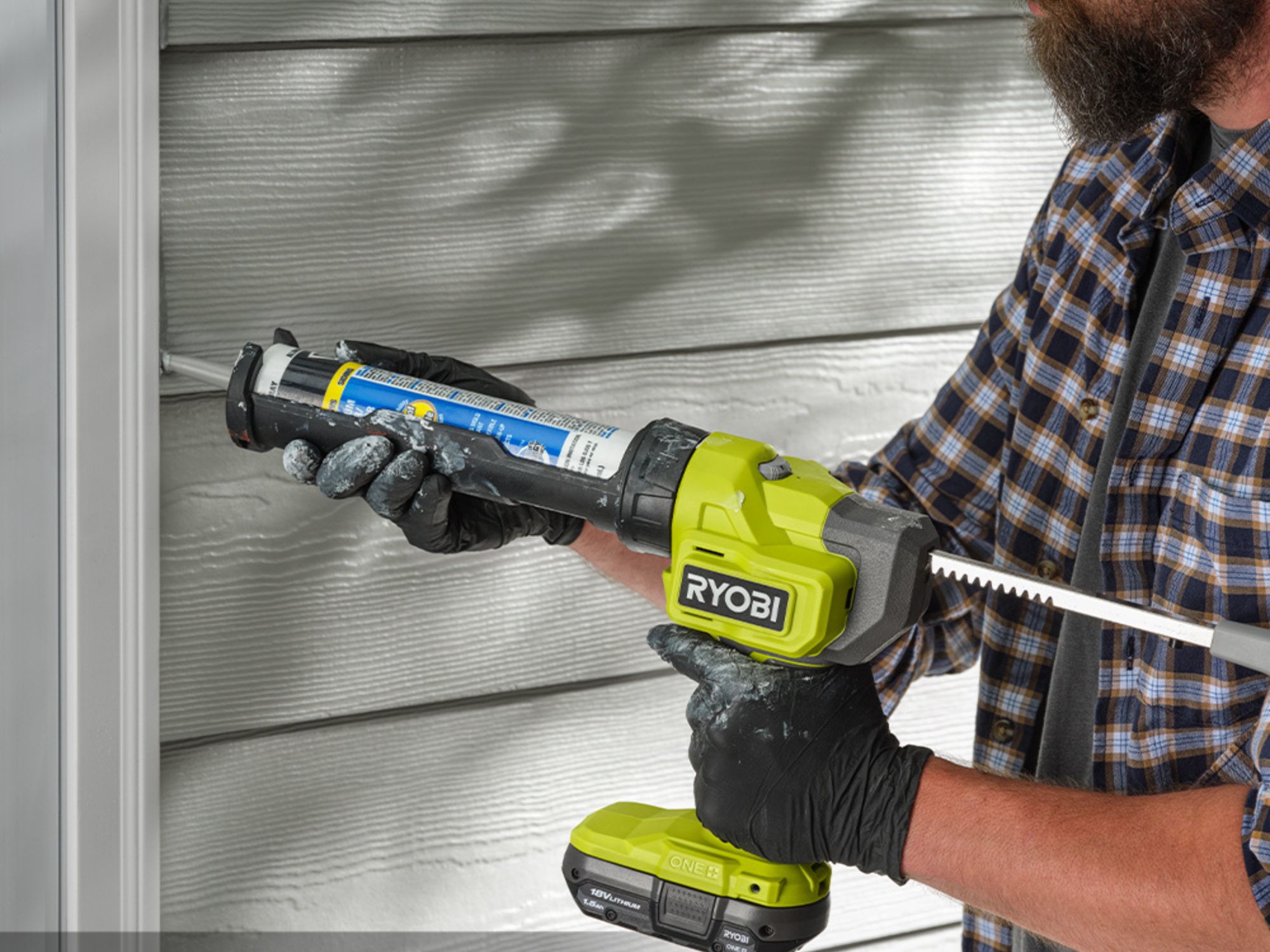
We may earn revenue from the products available on this page and participate in affiliate programs. Learn More ›
A cordless caulk gun can deliver a consistent, smooth flow of filler or sealant at a rate set by the user. They’re not just about speed, though; they also promise to be as controllable as a manual version. As soon as you take your finger off the trigger, the flow stops instantly.
For those with large caulking jobs to tackle, a cordless caulking gun means no more hand strain. And for those who apply caulk professionally, it could mean time savings that improve earnings.
We recently put several of these cordless caulking tools to the test to see how they’d perform in a variety of settings. Our favorite, the DeWalt DCE560B, is a high-quality device aimed at contractors that produced excellent results in testing. Our full selection of the best cordless caulk guns offers something for everyone, and for those on a tighter budget, we have included a couple of manual alternatives.
Best Overall
DeWalt DCE560B 20V MAX Caulking Gun
Product Specs
- Capacity: 10 ounces (300 milliliters)
- Length: 21.1 inches
- Weight: 4.6 pounds (without battery)
What We Like
- Excellent build quality and renowned durability
- Variable-speed trigger and dial for maximum control
- Automatic plunger retraction means no drips
What We Don’t Like
- It doesn’t come with the battery required for operation
- Won’t fit in tight spaces
The DeWalt DCE560B cordless caulk gun comes with the brand’s renowned build quality, reliability, and durability. It is also packed with features that will make life easier for any home remodeling enthusiast or professional. A manual caulk gun relies on finger pressure for consistent delivery. One of the main advantages of this battery caulk gun is that flow is extremely controllable; in order to precisely match user demands, there is both a variable-speed dial and a variable-speed trigger. The push rod automatically retracts when the trigger is released to prevent spills or wasted material.
Useful touches included are an LED work light and hanging hook. The Quick Connect canister tray can be swapped out for a sausage tube for those who use adhesives that come in that type of package.
Tom Scalsi, BobVila.com writer and tester, says that he likes that it “produces even and consistent results without wearing out our hands.” He went on to say, “We realize it’s expensive, but anyone applying construction adhesive to floor joists will find that this caulking gun pays for itself in a day or two.”
Get the DeWalt cordless caulk gun at Amazon, Lowe’s, or The Home Depot.
More Cordless Caulk Guns Worth Your Money

Among the best caulking guns we discovered during our hands-on testing are two manual models. The remainder are cordless caulk guns that offer a variety of price and performance options from entry-level to heavy-duty models.
- Newborn 250 Caulking Gun, available at Amazon or Lowe’s.
- Bates Choice Caulking Gun, available at Amazon.
- Craftsman V20 Cordless Caulk Gun, available at Amazon or Lowe’s.
- Ryobi One+ 18V Cordless Caulk Gun Kit, available at The Home Depot or Amazon (bare tool only).
- Milwaukee M12 12V Cordless Caulk Gun, available at Amazon or The Home Depot.
- Makita 18V LXT Cordless Caulk Gun, available at Amazon or The Home Depot.
- DeWalt DCE570B 20V MAX Caulking Gun, available at Amazon or The Home Depot.
Jump to Our Top Picks
How We Chose and Tested the Best Cordless Caulk Guns

As we considered the products for this article, we wanted to focus on the key differences between manual and cordless caulk guns. We also wanted to find out whether cordless caulk guns are worth the additional investment.
These tools are still relatively new to the market, so we were able to check out all of the dozen or so models currently available. The ability to control the gun is one of the most important features. Although it’s always possible to rectify errors using a caulk removal tool, it’s better if faults are avoided in the first place. Our carefully collated selection comprises the tools that came out top in terms of performance, versatility, and user-friendly features. We also looked at weight, canister changing, and price.
For a real-world view, we consulted with a professional contractor. The comments from Richard Garrett of construction specialists RG ProBuilders, located in Phoenix, Arizona, were typical. “My top tip is to consider your intended use and choose a model with adequate power and battery life. Our projects require industrial cordless caulk guns with high voltage, usually 18-volt or more, and fast recharge times.” He also points out a couple of user-friendly features not found on manual caulk guns: “Variable-speed triggers provide precision for detail work but also higher flow rates when needed. Built-in LED lights are extremely useful, especially when caulking shadowed areas.”
What to Consider When Choosing a Cordless Caulk Gun
Not surprisingly, a cordless electric caulking gun is a bit more complex than a manual model. For that reason, a number of key features will impact your buying decision. In the following section, we’ll take a close look at these and talk about how they could impact day-to-day use.
Battery
The battery plays a key role in performance, working time, and, to some extent, the overall size and maneuverability of the caulk gun. At the time of writing, the options were either 12 volt or 18/20 volt, which are effectively the same (you can find an explanation of voltage in our best cordless drills article). Although 12-volt cordless caulk guns can’t match the power of an 18-volt or 20-volt alternative, some are more compact because the battery slides into the handle rather than protruding from it.
Runtime and recharging times are important, though figures aren’t always readily available. Additionally, runtime will vary depending on the thickness of the caulk or adhesive used. The amp-hour (Ah) rating of the battery can make a significant difference too. If two batteries have the same voltage but one is 2 Ah and the other is 4 Ah, the latter will run for around twice as long. This is a key consideration when you’re buying batteries for any power tool or want to have a spare on hand. And since cordless caulk guns are often sold as bare tools, this is particularly true.
Thrust Ratio or Push Force and Caulk Compatibility
Manual caulk guns have a thrust ratio, which describes the amount of additional pressure exerted by the mechanism each time you squeeze the trigger. On cordless caulk guns this is called push force, and it’s generated not by finger pressure but by the motor.
A 12-volt model may be a more compact caulk gun, but in general will offer less push force than 18-volt or 20-volt alternatives. In the caulking guns listed above, the 12-volt Milwaukee produces 400 pounds, whereas the 18-volt Makita delivers up to 1,100 pounds. The less-powerful model will be fine when it’s used with silicones and many adhesives, but some caulks are thicker, which could cause problems.
That said, 18-volt models can also vary considerably in push force and can be as low as 550 pounds. If you are regularly using heavy-duty materials, you’ll want to check. Unfortunately, manufacturers don’t say which caulks their tools are compatible with, so those who use a wide variety of materials may want to maximize the push force to ensure the tool can handle the thickest materials. Professional caulking gun users may also want to consider a model that can take the larger 29-ounce canisters, thus reducing the need to change them so often. Of course, this type of large caulk gun is less easy to maneuver.
Additional Features
- Controlling the material flow is probably the most important feature of a cordless caulk gun. All the models we have seen have a speed control dial with five or six positions. They also have variable-speed triggers. Combining the two can allow for a very slow flow when only small amounts of material are required, or super-fast delivery when you’re working on large areas. They also allow for new users to start carefully and build up their working speed as they get accustomed to the tool.
- Physical size may be important for those who often work in cramped spaces. Those looking for a small caulking gun will probably want to consider a 12-volt model, as long as it provides adequate push force for the type of caulk being used.
- Some canister holders have a quick-change design that allows for two or more to be prepared in advance and then switched almost instantly. Many can be rotated to optimize the working angle.
- Several cordless models back off the plunger a little when the trigger is released, effectively providing a dripless caulking gun that doesn’t make a mess and can help prevent wasted material.
- An LED light is often provided, making it easier to see and maintain consistency when working in low-light conditions. A hanging hook is frequently included, and some incorporate a puncture tool. Sausage holders for materials supplied in soft containers may be available as an extra.
FAQs
Our product descriptions and the information provided on key features will have answered many of the questions that crop up about cordless caulking guns. However, during our research we did find a few of a more general nature, so we’ve answered those here.
Caulking guns are the tool of choice for creating a high-class finish, and it’s difficult to apply caulk or silicone successfully without one. Learning how to use a caulk gun isn’t hard, but it does take some practice.
Sometimes the names are interchangeable. It’s not unusual to see a product described as silicone caulk. However, it’s not a question of which is better but rather whether grout vs. caulk is the correct product for the job.
Caulk, sealant, and adhesive come in different size canisters, so the right size caulking gun is very important. In fact, not using a caulk gun that’s the right size for the job is one of 10 common caulking mistakes.
Meet the Tester
Tom Scalisi is a freelance writer specializing in the home design, construction, tools, and automotive industries. He has been involved in the trades for over 15 years as both a contractor and a commercial building mechanic. As a lover of all things tools, construction, and DIY, he’s always looking for new tools and techniques while also sharing his knowledge with the DIY world.
Additional research provided by Bob Beacham.

